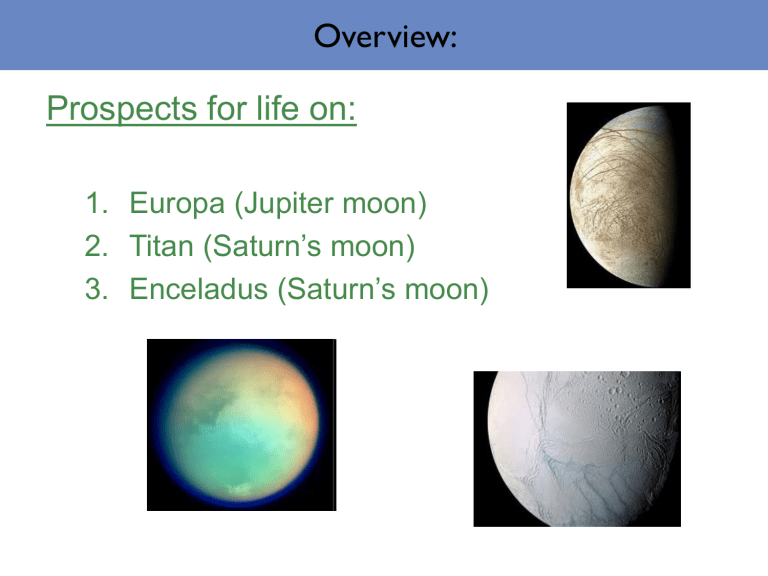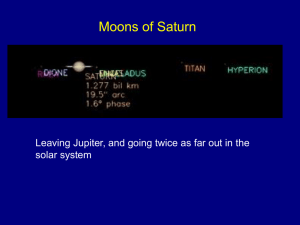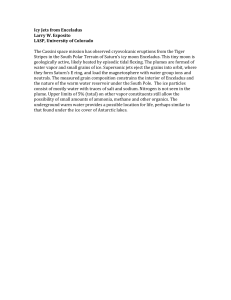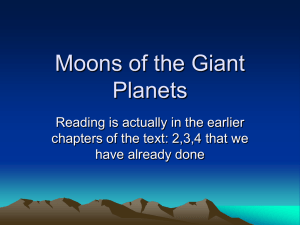Life on Europa, Titan, Enceladus: Prospects & Exploration
advertisement

Overview: Prospects for life on: 1. Europa (Jupiter moon) 2. Titan (Saturn’s moon) 3. Enceladus (Saturn’s moon) Life on Europa? NASA’s JUNO mission to Jupiter: Juno arrives at Jupiter in 2016 Science goals: 1. 2. 3. 4. abundances (e.g. ratio of O/H) determine core mass map the gravitational and magnetic field map the variation in atmospheric composition, temperature structure, cloud opacity and dynamics Life on Europa? • Europa is the sixth of Jupiter's known satellites and the fourth largest; it is the second of the Galilean moons. Europa is slightly smaller than the Earth's Moon. Galileo Galilei Europa 1610! Life on Europa? • Spacecraft exploring the Galilean satellites: Voyager 1 & 2 Galileo Europa: Europa’s surface is smooth and young (no craters), and is covered with cracks: Europa is tidally heated like Io (just less) and has maybe the youngest surface in the outer solar system! Icebergs on the surface moved by liquid water that later froze or by slushy warmer ice beneath? Europa Thera Macula & Thrace Macula Conamara Chaos Ridges Cycloids Plains Oceans – EUROPA has more water than total water on earth The Saturn System Titan: • The biggest moon of Saturn • Cold! 75 K (-180 C) - turns methane and other gases to liquid Its orange because of that. • It’s made up of about half rock and half frozen water • THICK ATOMSPHERE - The atmospheres pressure is 1.5 times Earth’s • 90 to 99% of the gas is Nitrogen. The rest is methane and very small amounts of hydrogen cyanide and acetylene. Origin? – Probably outgassing after formation by accretion of icy planetesimals/comets and subsequent evolution – Methane from cryovolcamism Titan: • Exploring Titan: Voyager 1 & 2 Cassini / Huygens Titan: • Titan as seen from space: visible 938nm methane window Different views based on the type of filters used composite First real look at Titan in 1979 with Voyager flyby Atmosphere so dense the surface is not visible Atmosphere primarily nitrogen (like Earth) but clouds are aerosols (smog) of some sort 25 years later…another spacecraft on a mission The Cassini and Huygens spacecraft The Huygens lander Concept of the Huygens lander…an artist’s conception The Huygens Probe Part of the Cassini mission Landed on Titan 1/14/05 Pictures of Titan from the approaching Cassini spacecraft Image at infrared wavelengths Near-IR image penetrates the haze and sees surface features Near-IR image (933 nm) The Sea? The Lake? Titan has flow channels, too The view from Huygens on the way down On the surface “rocks” are blocks of ice The most remote human “base” in the universe: nearly a billion miles from the Sun Cassini radar shows lakes of methane Recent observations from Cassini show different manifestation of methane lakes: sunlight glints from the lake surfaces The surface of Titan: an artist’s view Enceladus: Brightest object in Solar System except the Sun. Something has erupted to make the planet so smooth (water, volcanic, etc…) Named after a Titan that was killed by Athena Enceladus: Enceladus has the highest albedo (>0.9) of any body in the solar system. Its surface is dominated by fresh, clean ice. At least five different types of terrain have been identified on Enceladus. In addition to craters there are smooth plains and extensive linear cracks and ridges. At least some of the surface is relatively young, probably less than 100 million years. This means that Enceladus must have been active until very recently (and perhaps is still active today). Enceladus is much too small (500km) to be heated solely by the decay of radioactive material in its interior at present. But briefly after its formation 4.5 billion years ago short-lived radioisotopes may have provided enough heat to melt and differentiate the interior. That combined with modest present day heating from long-lived isotopes and tidal heating may account for the present day activity on Enceladus. Enceladus: Enceladus orbits in the densest region of Saturn’s E-ring Is it the source? Enceladus is currently in a 2:1 mean motion orbital resonance with Dione, completing two orbits of Saturn for every one orbit completed by Dione. This resonance helps maintain Enceladus's orbital eccentricity (0.0047) and provides a heating source for Enceladus's geologic activity Geysers Gas and dust plumes from occultation photometry. V=600 km/s March 2008 Cassini flyby Enceladus: Cassini discovers jet-like plumes rising from the south polar regions. During “fly-throughs” the spacecraft detected mostly water vapor, as well as minor components like molecular nitrogen, methane and CO2. Enceladus: Cassini measures mean density: 1.6 g/cm3 => some % of silicates & iron Now two heat sources: 1. Radioactive decay 2. Tidal forces Possible molten core or magma pockets that drive volcanism! Enceladus: The “Tiger Stripes” in the south polar region. Thermal map of cracks near south pole of Enceladus. High temperatures around 180 K (-135 F), normal = 72 K “Tiger Stripes” Enceladus Tiger Stripes IR-bright emission near the south pole of Enceladus Enceladus up close Enceladus: another case in which subsurface water flows up through cracks to the surface of the object Europa’s surface Europa’s surface No organics detected yet. Our best chance of reaching the ocean may be these features. If they are cracks they may contain ocean material Or plumes ?? Summary: • Europa likely has a liquid sub-surface ocean and is heated by tidal forces • Titan has complex organic chemistry and a thick nitrogen atmosphere (early Earth) • Enceladus is geological active, has lots of water, plus some organic material and a heated interior




